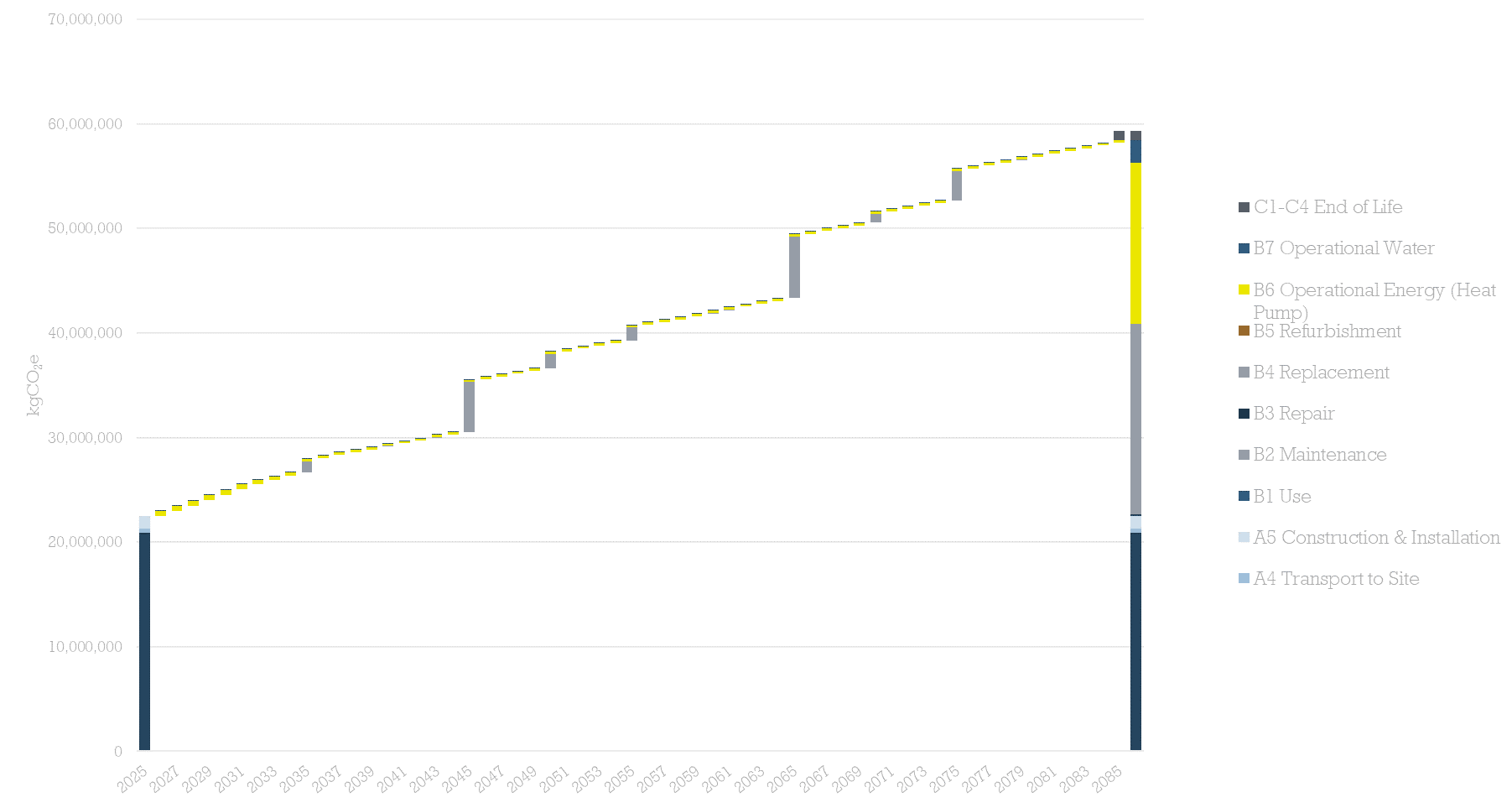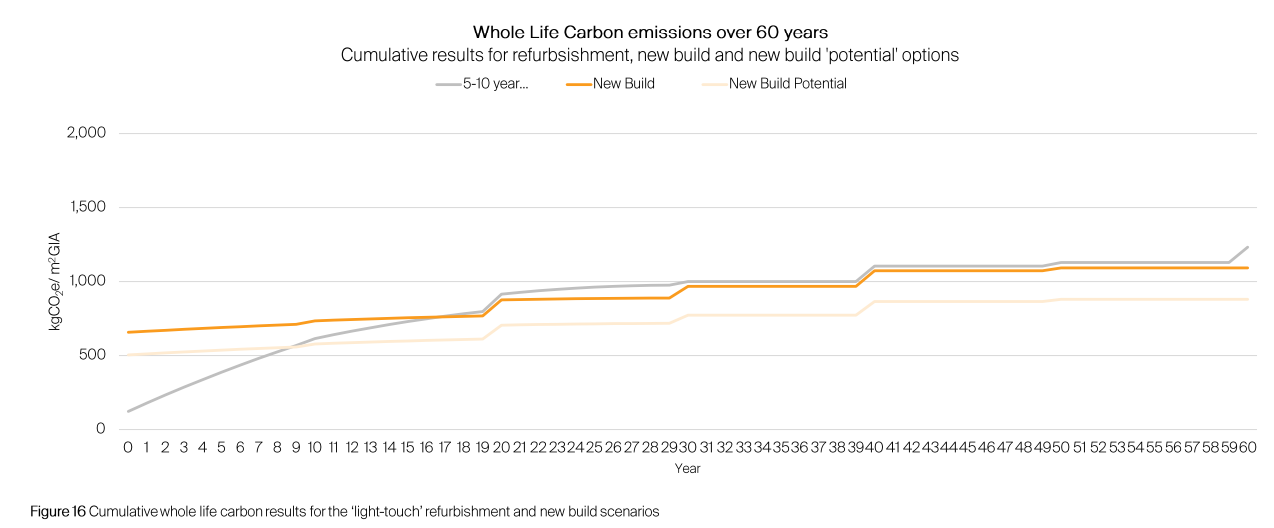
A Whole Life Carbon Greenwash Exercise?
Re-revealing our hidden emissions
🏗👷♂️🏦 = 🔥🌍
This article has been written, in part, to alleviate my own guilt complex but to also explain how the carbon emissions of the construction sector are generated and importantly, calculated/assessed and ultimately reduced.
The industry in which I work is extremely carbon intensive; in simple terms we take natural minerals and compounds of the earth and use fossil fuels to dig, transport, construct and fuel the product that is produced by our collective labour.
Working as a sustainability consultant within the built environment sector means that generally I work to reduce the impact that constructing buildings has on the natural world. I do also wonder of the true impact of my work however. E.g. if people with similar training and expertise didn’t talk to design teams and developers, how much worse off would we be?
You could look at the role I perform more cynically and say that my role, under the overarching goal of 'Sustainable Development'’, is to allow development to continue as long as it adheres to rules and guidance that somewhat limit/control/mitigate the impact on the natural world.
Now this is where it gets interesting for me. As sometimes adhering to rules & guidance, whilst having good intentions, can create a false narrative to make it seem that the objectives are being incrementally delivered. But if you took a step back and objectively measured progress against the original objectives, you might find that you have been treading water all along.
This is the general sentiment of this article, as I feel the aforementioned assertion might be happening in the emerging guidance on assessing the Whole Life Carbon impact of a building i.e. calculating the CO2 emissions for construction, in use and end of life.
Okay Nickelstats meme aside - actually look at this graph ⬇
This graph is taken from the ARUP Whole Life Carbon Assessment for the re-development of the Marks & Spencer's store on Oxford Street, London. This assessment and the re-development scheme it represents has received criticism by industry professionals like embodied carbon pro Simon Sturgis at Targeting Zero, which led to the scheme being delayed on the grounds to review it’s alignment with the Westminster City Council’s and the Greater London Authority’s own policy for reducing Whole Life Carbon.
From observing the above, it leads you to believe that out of the three scenarios of: 1) refurbishment, 2) new build and 3) potential new build, we could achieve a saving in carbon emissions throughout a 60 year life cycle if we demolished and built a new building.
This is somewhat carbon greenwash in disguise as it is misleading. The reason why is twofold:
The units of the graph are carbon intensity, not net carbon.
The options display the construction emissions and the ‘in-use’ emissions a 60 year reference period divided by the 61,000 m2 floor area. Whilst this is a useful metric for like for like comparisons of carbon ‘efficiency’ of a new development where the floor area is fixed or constrained, its use in comparing refurbishment options is misleading, as the total tonnage of carbon is being disguised by the significant floor area which is being generated by the new build option.
Carbon emitted tCO2e:
New build = ~61,000m2 x 650 kgCO2/m2* = 39,500 tCO2e
Refurbishment = ~22,000m2 x 80 kgCO2/m2* = 1,760 tCO2e
*Data taken from ARUP’s Whole Life Carbon Assessment & an estimate of the existing floor area. Note that the 80 kgCO2/m2 intensity is a significant underestimation for a refurbishment, however this simply references the data in the study. If this was higher at a more representitive intensity of ~400 kgCO2/m2, the total tCO2 of the new build would still dwarf a refurbishment option.
As this simple multiplication confirms; the option to demolish the existing building and construct the new building is 22 times the refurbishment option.
The net emissions cost of the new build in this case is 37,000 tonnes of CO2 emitted into the atmosphere. 👌👌👌
The refurbishment operational carbon trajectory is implausible.
The whole life carbon assessment report makes no reference to the data behind the incredibly steep operational carbon trajectory of the refurbishment scenario. This should be the historic carbon emissions performance of the existing building, as measured by the building energy meters and multipled by the carbon factor of the respective energy sources (grid electricity and natural gas most likely).
This scenario clearly models a scenario of high heating demand (poor thermal performance) using a fossil fuel boiler, as the gradient of the line is significantly higher than the proposed new build option.
Whilst this might represent the building as it currently operates; it’s highly unrealistic that this building will operate like this over the next 8 years, let alone for the next 30 years which the study seems to allow for. But how can we know this?
Well it might not even be legal to do so with the 2022 Part L update, the impending Future Building Standard (2025) and the Minimum Energy Efficiency Standards set to be implemented in the UK in 2027-2030. These legislative frameworks mean its highly probable that energy efficiency upgrades and low carbon heating (electric heat pump) will be required before the building owner can let the space.
Interestingly these legislative tools impacting the real estate industry are not far away in relation to the typical timescales of design and construction. If the project passed the planning stages, another year of design is likely. Add on a typical 2 year construction programme means that tenants might be moving in by 2025, whereby if the landlord hadn’t brought the building in line with revised legislation, they might have a comfortable couple of years before intrusive work is mandated to improve energy performance.
This “bottom up” approach to tighting legislation means that if the WLC assessors, the design team and Marks and Spencer Group PLC were objective in exploring a viable refurbishment option - these considerations will be accounted for within the analysis and no doubt the refurbishment scenario will show a less steep operational carbon trajectory, lower embodied carbon uplift and overall lower Whole Life Carbon Trajectory.
If you superimpose an energy/carbon efficient trajectory with the timescales discussed above, with a mandated ‘correction’ in the buildings energy performance in line with anticipated legislative requirements, you’ll get a trajectory like the violet line above. It’s likely that this would come out to be the lowest carbon option in a 60 year life cycle.
Its worth noting here that there was always an alternative option which was not even consisdered within the Whole Life Carbon Assessment, and that’s a refurbishment / remodelling option which both minimises the embodied carbon of the construction works AND improves operational emissions (improved fabric, air tightness & heat pumps).
The fact that this was omissed shows the true intent of the design team which was to control the narrative to make demolishing and rebuilding more favourable than it is, despite the forward thinking planning policy put in place to steer design teams towards low carbon development.
What to make of all this?
Looking at a specific example of a Whole Life Carbon Assessment on a building level is a really useful tool, as it really hits home the magnitude of emissions generated in construction, and the estimated ‘locked in’ emissions during operation.
As we work to curb the worst impacts of climate change through improving energy efficiency, reducing carbon intensity and maximising renewable energy, its important to not lose sight of the main goal - reducing the total tonnes of CO2e into the atmosphere.
When you see data produced by the International Energy Agency (IEA) (adjacent) that confirm that building energy use is increasing globally; and we are set to add 50 billion square meters of building floor area to the earth by 2030; it’s clear that we need to ensure that we are making the right decisions to actually curb emissions in the built environment.
Demolishing and reconstructing buildings in cities whilst advertising their carbon saving credentials through subjective analysis cannot be seen as a way forward.
Solidarity to the people and organisations working against the inertia of the climate-breakdown-inducing status-quo 🙌👏.



